Ask website Author at theorybin.com for any special photos or questions.
SOLD March 2017
Now on 30 day trial
Gone to San Francisco, Ca
![]() 1965 to 1967 Fender 12 string Stratocaster - This may be a 1st year of issue
depending how you interpret the serial # info. Excellent
condition with original case and no repairs. The same guitars in
poor condition asks 12k to 22k on ebay. This is in better shape than their
best listed.
1965 to 1967 Fender 12 string Stratocaster - This may be a 1st year of issue
depending how you interpret the serial # info. Excellent
condition with original case and no repairs. The same guitars in
poor condition asks 12k to 22k on ebay. This is in better shape than their
best listed.
I am looking for $2500 and hesitating to sell , this might go on consignment at a dealer in Kansas City. For feedback, questions, or detailed photos, contact the Host of theorybin.com.
The Jagged edges are image edits, this is a very smooth body guitar.
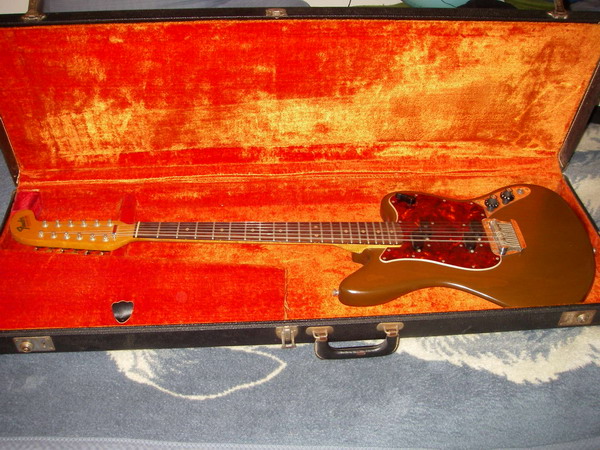
Good original case - no key to the lock
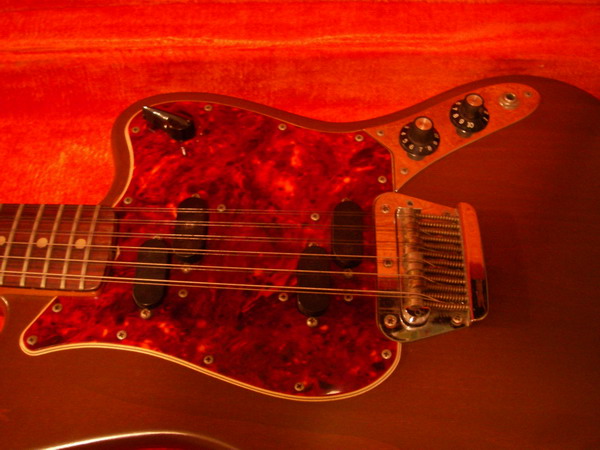
Sustain is great - keeps tune forever if strings are well used
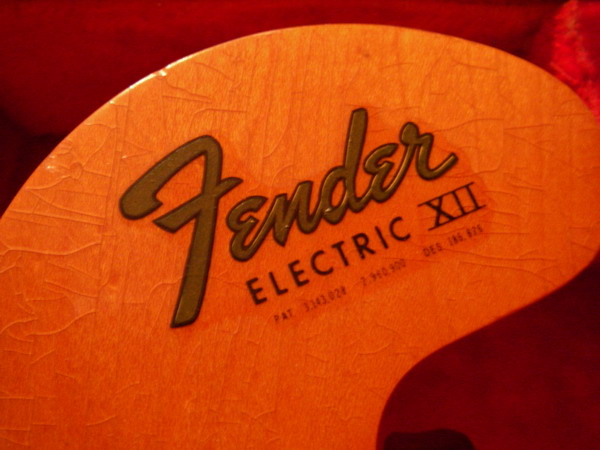
Cracks in varnish are amplified by the flash of the camera
The decal # Pat. 3,143,028 2,940,900 Des 125,875
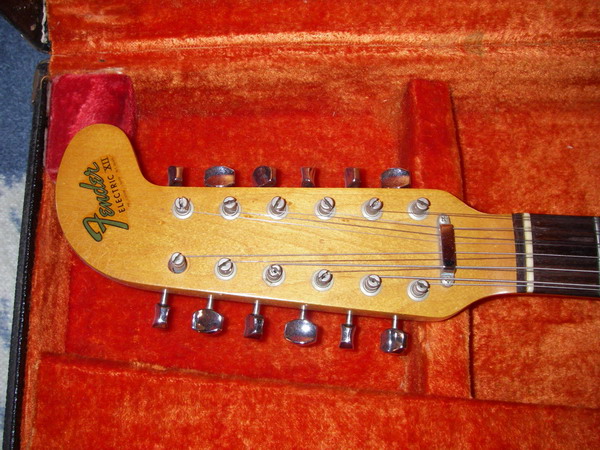
The grommet is missing from one peg. The grommets are replaceable if I get it to a shop.
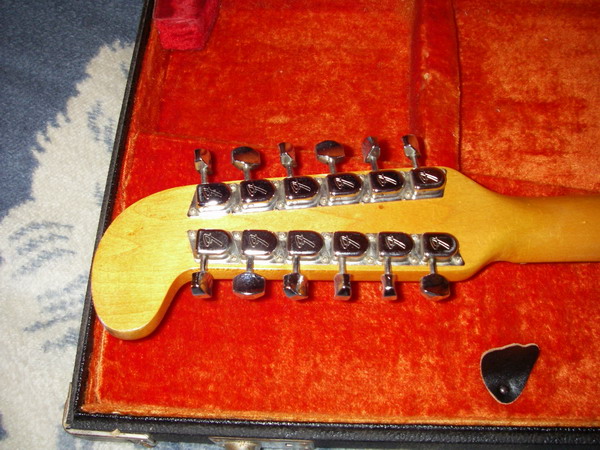
No major dings on this guitar - one is on the back 2" below the serial # plate. This ding does not crack the finish.
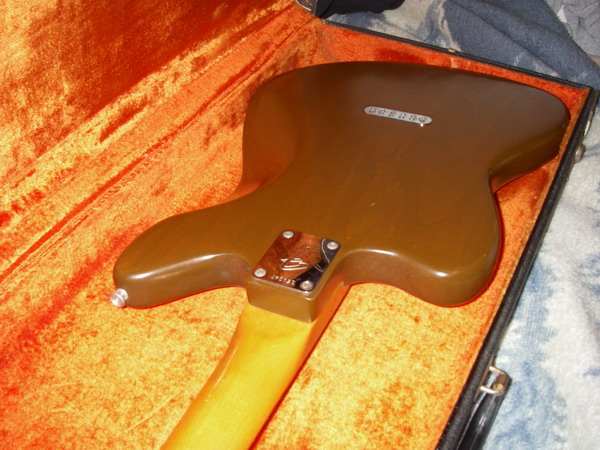
Body contour on this guitar is the most comfortable of any I know.
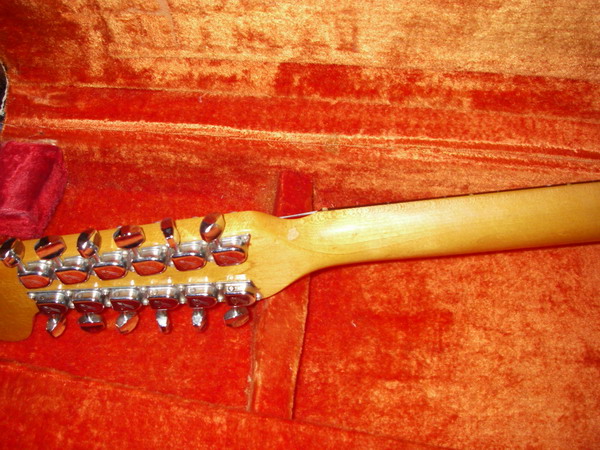
The lacquer is worn through on the top of the neck where my thumb rests. This was likely from a hanging stand that is no longer used.
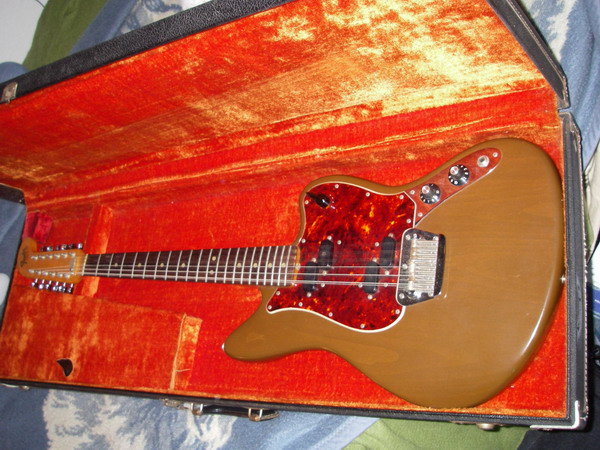
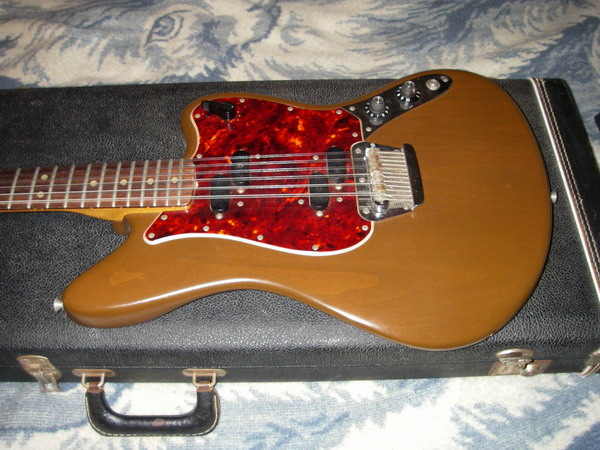
Some surface corrosion on the string bridge - will buff off but return.
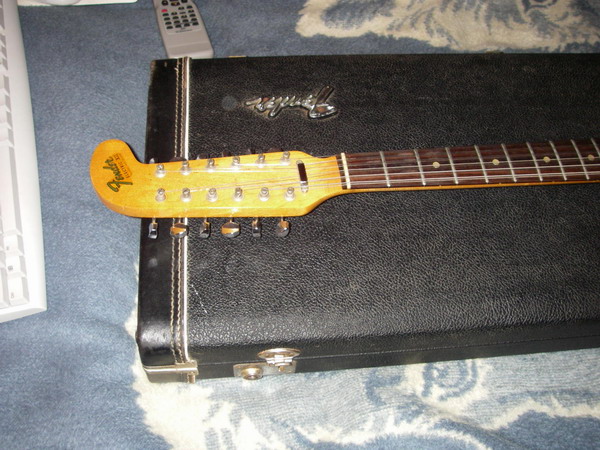
Some visible wear on the top three frets and board
Note that this guitar has the "clay" fingerboard dots that ended in 1964
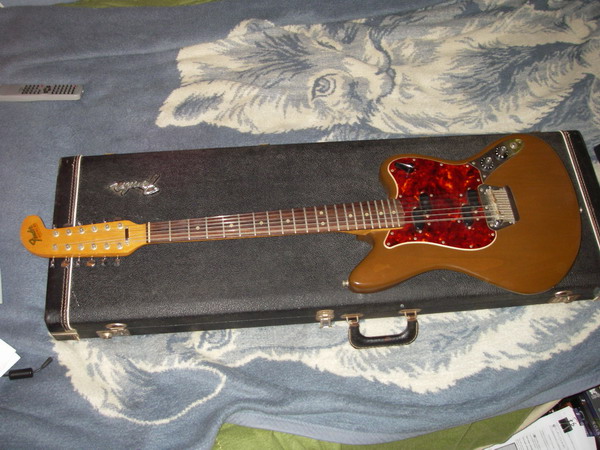
Four position pickup switch gives great sound variations.
Sound example: A Fender-12 Stratocaster was used by Led Zeppelin's Jimmy Page, in Stairway to Heaven and Thank You. He also used a Telecaster in Stairway, but the famous melody was with a 1965 12-String Stratocaster.
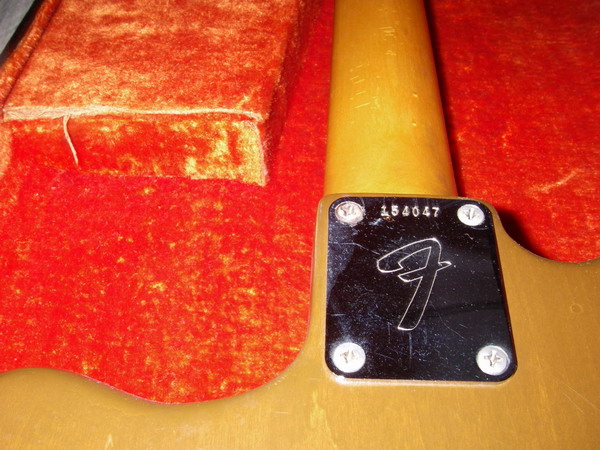
The Serial Number of this Guitar has an F-stamp with the numbers 154047. Since there are conflicting dating lists with these and other sources, the age of this guitar is up to you. The listing of the 12 string dates it in 64-65, with the dots and tortoiseshell at pre-65. But the chart of 6-stringers identifies a 1966 to 1967, from the F-stamp and F-gears.
The paragraphs below are mostly identifying the 6-strings and note that 1965 has pearl dots that replaced the gray dots. This guitar has the round gray dots. I have not figured out what a white binding is, unless it is the white trim around the pick guard.
The 1968 spec says that the F gears replaced the Kluson gears. This guitar has the F gears. I have not seen any other with solid Brown Mist body, most have a starburst. The 63 to 65 had the red tortoiseshell pickguard.
The wear on this guitar is minimal. The lacquer is worn through on the top of the neck where my thumb rests. This was likely from the hanging stand. I no longer use that stand. The area is still smooth and useable.
The head posts have a brass grommet that covers the hole below the string slot. One is missing from this head and I really am curious of how that happened. I don't know where it went, but I have seen sets on ebay that go for 2 to 12 bucks. I haven't yet attempted to get one.
The original style of brass wound strings were on it when I ran off to Germany in '79. When I returned, it had the silver bullets that were normally used in my 6-string Strat. (brother effect) I think it sounded better with the old style strings. That may change if I get to playing it again.
- - - - - - - - - - - - - - - - - - - - - - - - - - - - - - - - - - - - - - - - - - - -
Information from http://www.provide.net/%7Ecfh/fender2.html
The
Fender Electric XII.
Collectibility Rating: D.
Introduced in late 1965, this model had unusual split pickups, much like a Precision bass. As with most twelve string guitars, its value is low especially compared to six string models. Designed by Leo Fender, the Fender Electric XII was introduced with the bulk of the production taking place in 1966. The model was discontinued around 1970. Unlike its competitorsí electric 12-string models, which were simply existing 6-string guitars with six more strings, the Fender Electric XII was a ground-up 12 string designed to capture part of the folk-rock market. The headstock was different from Fenderís usual 6 on-a-side shape, and is sometimes referred to as a "hockey stick". Leo Fenderís bridge design for this model is very simple, works well, and may be one of Fender's best designs of the 1960s. The bridge has an individual saddle for each string, allowing for precise intonation. A string-through-body design also helps to increase sustain.
Mid 1965 Electric XII specs:
- Rosewood fingerboard with pearl dots.
Late 1965 Electric XII specs:
- White binding on neck.
Mid 1966 Electric XII specs:
- Rectangle position markers replace dots.
1968 Electric XII specs:
- Black Fender decal.
- "F" style tuning gears replaces "Kluson-Deluxe" gears.
- Polyester thick finish replaces nitrocellulose lacquer.
1969 Electric XII discontinued.
- - - - - - - - - - - - - - - - - - - - - - - - - - - - - - - - - - - - - - - - - - - -
The following information also originated from http://www.provide.net/%7Ecfh/fender2.html I can't vouch for it's accuracy, but there are many resources and more information on the web. Note that most info is for 6-strings.
1964 & 1965 Fender Stratocaster Guitar (6-String)
Description:
1964 & 1965 Fender Stratocaster guitar
Available: 1954 to present.
Collectibility Rating: C
Production: no official (or unofficial) production numbers
available.
General Comments:
The Fender Stratocaster guitar is probably the most popular solidbody
electric guitar ever made. Early models (1954 to 1965, known as
"pre-CBS" models, since CBS Broadcaster Company bought Fender in January
1965) are the most collectible. Originality and condition are the two
most important features of a vintage Fender Stratocaster guitar, and
Fender Strats do seem to have been easily modified (due to their "bolt
together" nature).
1964 and 1965 brought a number of changes to the Fender Stratocaster (and none of them good). By mid-1964, the peghead "Fender" logo changed from the petite (and rather cute) thin "spaghetti" logo to a more bold "transition" logo. The finishing procedure also changed for the Stratocaster at about the same time, allowing Fender to use body wood of lesser visual quality (and also making the sunburst finish look less appealing). By the fall of 1964 "clay" fingerboard dots where changed to Pearloid (a plastic that looks like pearl), and late 1964/early 1965 brought a change in pickguard material from the mint-green celluloid to a more stark white ABS plastic. Other minor changes ensued, all to make the production of the Fender Stratocaster quicker (cheaper). By December 1965 Fender also changed from the "L-series" serial number format on the neck plate to a "F-series" (there was now a large script "F" stamped into the metal neck plate). This change, and the enlargement of the Strat's peghead signify the end of the "pre-CBS" Fender Stratocaster (hence large peghead 1966 Fender Stratocasters are not considered pre-CBS models).
Serial number range for the 64 Fender Stratocaster are generally L20000 to L55000 (on the neck plate). Serial number range for the 65 Fender Stratocaster are generally L55000 to L99999 (on the neck plate). If you need to figure out the exact year of your pre-CBS Fender Stratocaster, use the serial number and the general features of the guitar. The serial number is located on the back metal neck plate. See the Fender Serial Number Info web page for help determining the year.
If you have a vintage pre-CBS Fender Stratocaster guitar for sale, please let me know. I am a private vintage guitar collector (not a store), and you can contact me at cfh@provide.net
- - - - - - - - - - - - - - - - - - - - - - - - - - - - - - - - - - - - - - - - - - - -
Note that this info is for 6-strings.
In January of 1965, Fender was sold to the CBS Corporation. The serial numbers do not immediately reflect the change, as CBS continued to make instruments using existing, tooling, parts, and serial number schemes. The following chart details the Fender serial number schemes used from 1965 to 1976. You will notice that there is quite a bit of overlap of both numbers and years.
|
SERIAL NUMBERS |
PRODUCTION DATES |
|
L50,000s up to L90,000s |
1965 |
|
100,000s |
1965 |
|
100,000s to 200,000s |
1966 to 1967 |
|
200,000s |
1968 |
|
200,000s to 300,000s |
1969 to 1970 |
|
300,000s |
1971 to 1972 |
|
300,000s to 500,000s |
1973 |
|
400,000s to 500,000s |
1974 to 1975 |
|
500,000s to 700,000s |
1976 |
Home Author Bible-Study Mysteries WebLinks Family
Physics Politics Electronics Radio Baseball
Writers Email-Author Music Spitfire Beach
Copyright © 2004-2024 by Steven C. Buren.
This text may be duplicated for use in classrooms and public speaking,
provided the Theorybin.com origin information is added.
This page was last updated 03/27/24 by Steven C. Buren